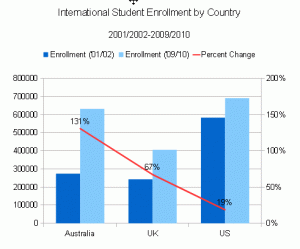Demand for international education in the last decade has been driven by strong growth in the numbers of Indian and Chinese students seeking to study abroad, with most being absorbed by schools in the UK and Australia. According to Dr. Rahul Choudaha of DrEducation.com, this is partly the result of tightening US immigration restrictions post 9/11.
The UK’s international student population increased 67% from 2001-2009, Australia’s 131% but the US’ only 19%. Choudaha argues this kind of growth is unsustainable:
Another major characteristic of the growth has been over-dependence on top two source countries–China and India. For example, proportion of Chinese and Indian students has doubled in Australia and the UK from 22% in 2002 to 44%. Likewise, every fourth international student in the UK and every third international student in the US is from China or India. This over-reliance on two markets highlights that countries and institutions have to make sure that they do not lose these markets at the same time develop other markets as a de-risking strategy [sic].
He also predicts some of that growth will shift back to the US:
Some of the early reports of fall 2011 enrollment are showing significant increases in international student enrollment. For example, at the University of Iowa first-time freshmen international student enrollment reached a record level of 484, as compared to 388 last year. Likewise, for Arkansas State University international student enrollment for fall 2011 crossed 1,000 students for the first time, as compared to 780 students last year. Even last year, public universities had shown healthy growth in international enrollment.
